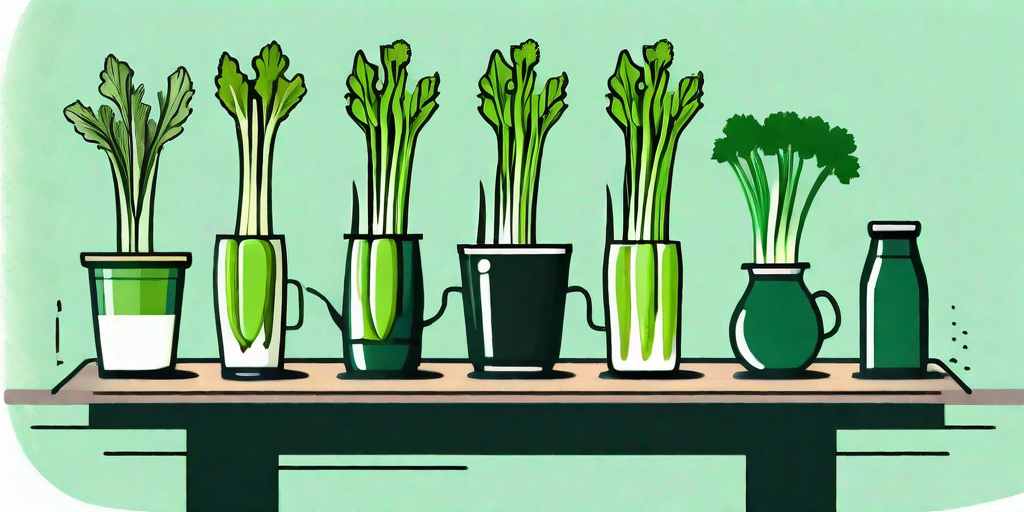
Welcome to the world of celery, a humble vegetable that's often overlooked, but packs a punch in terms of flavor and health benefits. Whether you're a fan of the crunchy stalks or you're just dipping your toes into the celery pool, this guide will help you navigate the different varieties and uses of this versatile veggie.
Understanding the Celery Universe
Before we dive into the crunchy details, let's take a moment to appreciate the sheer variety of celery out there. From the common Pascal celery to the lesser-known celeriac, there's a whole world of celery waiting to be explored.
But don't worry, we're not going to leave you stranded in the celery wilderness. We're here to guide you through it, one stalk at a time. So, buckle up and get ready for a crunchy adventure!
The Common Pascal Celery
Let's start with the most common type of celery, the Pascal celery. This is the celery you're most likely to find in your local grocery store. It's characterized by its long, green stalks and its strong, slightly bitter flavor.
But don't let the bitterness scare you away. When used correctly, Pascal celery can add a refreshing crunch and a burst of flavor to your dishes. Plus, it's packed with vitamins and minerals, making it a healthy addition to your diet.
The Lesser-Known Celeriac
Next up is celeriac, also known as celery root. Despite its name, celeriac is not the root of the Pascal celery, but a different variety altogether. It's characterized by its knobby, brown exterior and its mild, earthy flavor.
Don't be put off by its ugly duckling appearance. Once you peel away the outer layer, you'll find a delicious root that can be used in a variety of dishes. From soups to salads, celeriac is a versatile ingredient that deserves a spot in your kitchen.
How to Use Celery in Your Cooking
Now that we've covered the different types of celery, let's move on to the fun part: cooking with celery. Whether you're a seasoned chef or a cooking novice, there are plenty of ways to incorporate celery into your meals.
But before we get into the nitty-gritty, let's address the elephant in the room: yes, you can eat celery raw. In fact, it's a great way to enjoy its crunch and flavor. But if you're looking for more exciting ways to use celery, read on.
Using Pascal Celery
Pascal celery is a staple in many dishes, from soups to stir-fries. Its strong flavor makes it a great addition to savory dishes, while its crunch adds texture to salads and snacks.
One of the most popular ways to use Pascal celery is in a mirepoix, a mix of diced vegetables that's used as a base for many dishes. Just chop up some celery, carrots, and onions, and you've got yourself a mirepoix. It's a simple way to add depth and flavor to your dishes.
Using Celeriac
Celeriac, on the other hand, is more versatile than its stalky cousin. It can be used in a variety of dishes, from soups to roasts. Its mild flavor makes it a great substitute for potatoes, while its starchy texture makes it perfect for purees and mashes.
One of the most popular ways to use celeriac is in a remoulade, a classic French dish. Just grate some celeriac, mix it with mayonnaise, mustard, and lemon juice, and you've got yourself a delicious remoulade. It's a simple yet sophisticated dish that's sure to impress your guests.
FAQs about Celery
Still got questions about celery? Don't worry, we've got you covered. Here are some of the most frequently asked questions about celery, along with our cheeky answers.
Is celery a negative-calorie food?
Contrary to popular belief, celery is not a negative-calorie food. While it's low in calories and high in fiber, your body still uses energy to digest it. So, while it's a healthy snack, don't rely on it to lose weight.
Can I grow celery at home?
Absolutely! Growing celery at home is a fun and rewarding project. All you need is a celery stalk, a bowl of water, and a little patience. Just remember, celery is a cool-weather crop, so it's best to grow it in the spring or fall.
What's the best way to store celery?
The best way to store celery is in the refrigerator. Wrap it in aluminum foil to keep it fresh and crunchy for longer. And if your celery starts to wilt, don't throw it away. Just soak it in cold water to revive it.
Conclusion
And there you have it, a comprehensive guide to the different varieties and uses of celery. From the common Pascal celery to the lesser-known celeriac, there's a whole world of celery waiting to be explored. So, why not give celery a chance? You might just find your new favorite vegetable.
Remember, celery is more than just a diet food. It's a versatile ingredient that can add flavor and texture to your dishes. So, don't be afraid to get creative with celery. After all, cooking is all about experimenting and having fun. Happy cooking!











